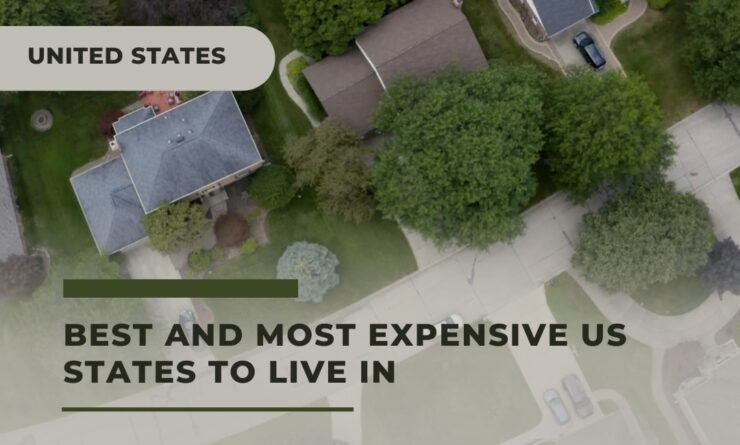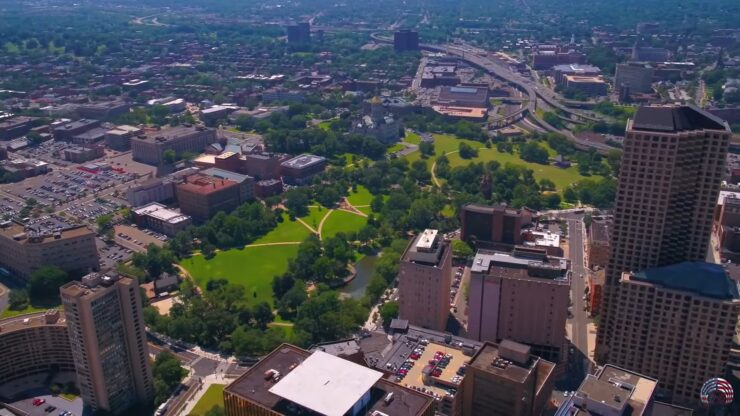Based on the varying costs of essential needs like food, energy, healthcare, and transportation across the U.S., we can see significant price disparities. These discrepancies can be so drastic that housing in one state may cost over 200% more than the national average, while healthcare in another state may run 51% higher than the typical national cost.
To identify the most expensive states to live in, I conducted an analysis of the annual living expenses across all 50 states using data from the 2021 Consumer Expenditure Survey, the most recent data set available from the Bureau of Labor Statistics. The cost of living indexes were evaluated for housing, groceries, utilities, healthcare, and transportation, and the total annual expenditures for each living cost were compiled.
The final ranking of the most expensive states was based on the sum total of annual expenditures in each state. Here are the top ten priciest states to live in, presented in reverse order.
10 Top and Luxurious Places To live
| State | Cost of Living Index | Annual Expenditures | Housing Costs | Healthcare Costs | Utility Costs | Transportation Costs | Grocery Costs |
|---|---|---|---|---|---|---|---|
| New Hampshire | 114.7 | $76,766 | – | $7,017 | – | – | – |
| Connecticut | 115.4 | $77,235 | – | – | $5,376 | – | 99% |
| Vermont | 116.4 | $77,904 | – | – | – | 21.3% above average | – |
| Oregon | 122.2 | $81,786 | 56% above average | – | – | 25% above average | – |
| Maryland | 124.1 | $83,058 | 57% above average | 5.6% lower | – | – | – |
| Alaska | 125.5 | $83,995 | – | 51.7% above average | – | – | 38.4% above average |
| New York | 135.7 | $90,821 | 94% above average | 3% above average | 0.6% above average | 5.6% above average | 9% above average |
| California | 138.7 | $92,829 | 94% above average | – | 22% above average | – | 12% above average |
| Massachusetts | 149.9 | $100,325 | 117% above average | – | 21% above average | 34% above average | – |
| Hawaii | 186 | $124,486 | 207% above average | – | – | – | – |
New Hampshire
- Cost of Living Index: 114.7
- Annual Expenditures: $76,766
Living in New Hampshire comes with higher-than-average costs for housing, utilities, and transportation. However, healthcare is particularly costly, standing as the second-most expensive among the states on this list. It’s 28.7% above the national average, equating to $7,017 per year, which is over $1,500 more than the national average of $5,452 annually. The lack of regulation and accountability in the state’s healthcare system is a contributing factor, as per NH Business Review.
Connecticut
- Cost of Living Index: 115.4
- Annual Expenditures: $77,235
Connecticut’s grocery costs hover just below the national average, around 99%. However, the cost of utilities here tops the list, standing at 27% higher than the national average, costing $5,376 against the national $4,223. The region’s dependence on natural gas for power plants partially explains these high costs, as reported by CT Insider.
Vermont
- Cost of Living Index: 116.4
- Annual Expenditures: $77,904
Living in Vermont means facing costs for groceries, utilities, healthcare, and transportation that exceed the national average. However, utilities and transportation are notably high, being 22% and 21.3% above the national average respectively. Vermont’s position at the end of the energy pipeline, making energy costlier, and the extensive use of natural gas by domestic consumers are factors that affect these costs, as per Vermont Public.
Oregon
- Cost of Living Index: 122.2
- Annual Expenditures: $81,786
In Oregon, housing is the chief concern, with costs standing at 56% higher than the national average, $20,696 annually versus $13,258. Housing demand-supply issues have escalated since the pandemic with many people moving to Oregon from cities like Seattle and San Francisco. Additionally, transportation costs are also 25% above the national average.
Maryland
- Cost of Living Index: 124.1
- Annual Expenditures: $83,058
All living costs in Maryland are higher than the national average, except for healthcare, which is 5.6% lower. Housing costs are the main concern, being 57% higher than the national average, once again due to demand-supply issues.
Alaska
- Cost of Living Index: 125.5
- Annual Expenditures: $83,995
Healthcare in Alaska is the most expensive on this list, 51.7% above the national average. This high cost is attributed to limited competition among medical providers, high provider compensation, and higher hospital profit margins as reported by Alaska Common Ground. Furthermore, grocery costs are 38.4% higher due to Alaska’s geographical location and reliance on container ships for food supplies.
New York
- Cost of Living Index: 135.7
- Annual Expenditures: $90,821
In New York, housing costs are dramatically high, 94% above the national average, while groceries are around 9% higher. Utilities cost is only slightly above the national average at 0.6%, while healthcare and transportation are 3% and 5.6% above the national average respectively.
California
- Cost of Living Index: 138.7
- Annual Expenditures: $92,829
California’s housing costs mirror New York’s, being 94% higher than the national average. Groceries are roughly 12% higher, while utility costs are about 22% above the national average.
Massachusetts
- Cost of Living Index: 149.9
- Annual Expenditures: $100,325
Massachusetts has the second-highest housing cost on this list, a staggering 117% over the national average. Factors such as inflation, land costs, labor, and materials contribute to this high cost, according to CBS News Boston. Additionally, transportation costs are 34% over the national average, and utility costs are about 21% higher.
Hawaii
- Cost of Living Index: 186
- Annual Expenditures: $124,486
Hawaii, while a paradise, is the priciest state in the U.S. The overall cost of living is 86% higher than the national average, and housing costs are an astonishing 207% above the national average. The exorbitant housing costs are a result of strict housing regulations causing a supply shortage. Joe Kent of the Grassroots Institute of Hawaii said, “On average, it takes over 10 years for home builders to turn a raw piece of land into a house, and sometimes it takes even longer.”
Methodology of Research
We carried out a comprehensive survey of the annual living expenses in all 50 states, relying on data from the 2021 Consumer Expenditure Survey (the most recent available) provided by the Bureau of Labor Statistics. We focused on the core costs of living, namely housing, groceries, utilities, healthcare, and transportation – which We collectively labeled as “necessities”. In addition to these, We also calculated the total annual expenditure for each state.
Using the cost of living index for each category obtained from the Missouri Economic Research and Information Center’s 2022 Q3 Cost of Living Data Series, We computed the annual cost for each necessity and the overall expenditures. The final ranking of states was determined exclusively based on their total annual expenditures.
Additionally, I acquired the median household income data for each state from the 2021 American Community Survey. All the data was gathered and updated as of January 3, 2024.
For those seeking a more economical lifestyle without sacrificing career prospects, you might be interested in more affordable places that offer job opportunities.
FAQs
1. What makes Hawaii the most expensive state to live in?
Hawaii is the priciest state to live in primarily due to its exorbitant housing costs, which are 207% above the national average. This is largely because of stringent housing regulations that lead to a supply shortage. Other factors include its geographic isolation, which increases costs for items that need to be imported, like food and energy.
2. Why are healthcare costs so high in Alaska?
Healthcare in Alaska is 51.7% above the national average. The primary reasons are limited competition among medical providers, high compensation for providers, and higher hospital profit margins. The geographical remoteness of Alaska also contributes to this, making access to healthcare more challenging and costly.
3. Why is housing significantly expensive in California and New York?
Both California and New York have housing costs that are 94% higher than the national average. This is largely due to the high demand for housing, coupled with a lack of sufficient supply. Both states have seen significant population growth in their major cities, driving up the cost of housing. In addition, strict zoning laws, high land and construction costs, and desirable locations contribute to the high prices.
4. What contributes to the high cost of utilities in Connecticut?
Connecticut has utility costs that are 27% higher than the national average. The primary factor for this is the state’s reliance on natural gas for power plants. Fluctuating prices of natural gas, coupled with the high cost of maintaining and upgrading the state’s energy infrastructure, result in higher utility bills for consumers.
5. Why are grocery costs so high in Alaska?
Grocery costs in Alaska are 38.4% above the national average. This is primarily due to the state’s geographical location. Being relatively isolated, much of the food supply in Alaska has to be transported a great distance, either by ship or air, which adds to the overall cost. The lack of farming infrastructure and shorter growing seasons also contribute to the higher grocery costs.
6. What makes living in Massachusetts expensive?
Massachusetts is one of the priciest states to live in due to several factors. The housing costs are the second highest on the list, 117% above the national average.
This is due to factors like high land costs, expensive labor and materials, and inflation. In addition, transportation costs are 34% above the national average, and utility costs are 21% higher, contributing to the high cost of living.
Final Words
In conclusion, the cost of living in the United States varies significantly from state to state, influenced by factors such as housing demand, healthcare access and quality, geographical location, and the regional economy.
Our analysis of the annual living expenses across all 50 states, as per the 2021 Consumer Expenditure Survey, revealed that the most expensive states to live in were Hawaii, Massachusetts, California, New York, and Alaska, primarily due to exceedingly high housing and healthcare costs.
However, it is important to consider that a high cost of living does not always equate to a lower quality of life. Many of these states offer strong economies, high-quality healthcare, and unique cultural and natural attractions that may offset their high living costs. Additionally, these costs often correlate with higher wages and salaries.
Nevertheless, these figures highlight the importance of understanding the cost of living and its components when making decisions about where to live, work, or retire. It’s also a reminder of the ongoing need for effective policies to address these disparities, ensuring that everyone has access to affordable housing, healthcare, and other essential needs.



















